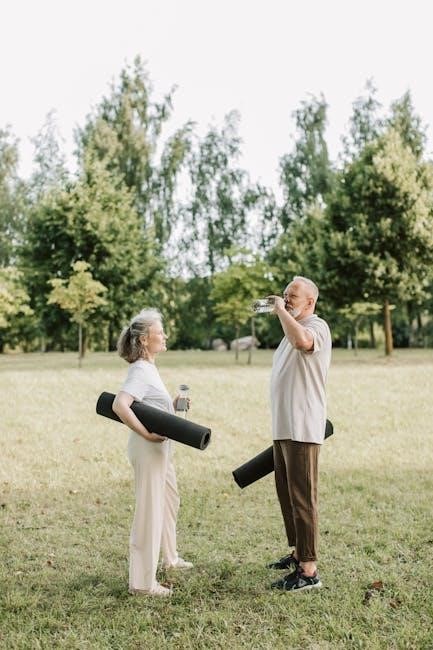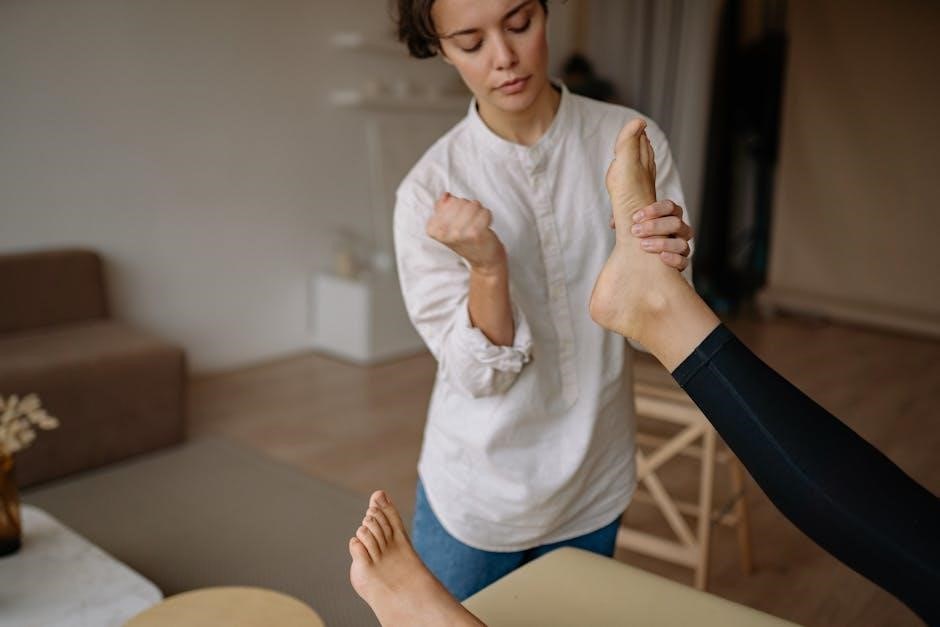The quadratus lumborum (QL) muscle is a deep core muscle running from the lower rib cage to the pelvis, playing a key role in posture, stability, and movement. Strengthening it enhances core stability and reduces lower back tension, essential for overall spinal health and functionality.
1.1. Understanding the QL Muscle and Its Functions
The quadratus lumborum (QL) muscle is a deep abdominal muscle connecting the lower ribs, lumbar spine, and pelvis. It plays a crucial role in stabilizing the trunk, pelvis, and lower back during movements like side bending, extension, and spinal rotation. The QL muscle supports posture, facilitates breathing, and assists in transferring forces between the upper and lower body. Stress from activities like golfing, running, or prolonged sitting can lead to QL tension, affecting spinal alignment and movement efficiency.
1.2. Importance of Strengthening the QL Muscle
Strengthening the quadratus lumborum (QL) muscle is essential for maintaining proper spinal alignment and reducing lower back pain. A strong QL enhances core stability, improves posture, and supports dynamic movements. Weakness in this muscle can lead to poor posture, reduced athletic performance, and increased risk of injury. Regular QL exercises help prevent stiffness and tension, promoting overall lumbar health and functionality in daily activities.

Warm-Up Routine Before QL Strengthening Exercises
A proper warm-up prepares the QL muscle for exercise, enhancing flexibility and reducing injury risk. It typically includes light cardio and dynamic stretches targeting the lower back and core muscles. This routine ensures optimal readiness for strengthening exercises, promoting both safety and effectiveness during the workout session.
2.1. Recommended Warm-Up Activities
Engage in light cardio such as walking or stationary cycling for 5-10 minutes to increase blood flow. Dynamic stretches like leg swings, arm circles, and cat-cow stretches are ideal for preparing the QL muscle and lower back. These activities enhance flexibility and reduce stiffness, ensuring the body is ready for strengthening exercises. This routine promotes optimal muscle activation and injury prevention.
2.2. Duration and Intensity of Warm-Up
Aim for a warm-up duration of 5-10 minutes, focusing on low-intensity activities like brisk walking or cycling. This ensures gradual preparation of the QL muscle without overexertion. Maintain a moderate pace to avoid fatigue, keeping movements controlled and deliberate. This approach safely transitions the body to the upcoming strengthening exercises, optimizing readiness and reducing injury risk. Consistency is key for effective preparation.
Stretching Exercises for the Quadratus Lumborum
Stretching the QL muscle is essential for improving flexibility and reducing tension. Exercises like the cat stretch and side bend stretch target the QL, enhancing posture.
3.1. Cat Stretch for QL Muscle
The cat stretch is an effective exercise for the QL muscle, promoting flexibility and relieving tension. Start on hands and knees, then arch your back, tucking your chin toward your chest. Next, round your spine, pulling your navel toward the floor. Hold each position for 20-30 seconds, repeating 2-3 times. This gentle stretch improves posture and reduces stiffness in the lower back. Smooth movements are key to avoid discomfort.
3.2. Side Bend Stretch for QL Muscle
The side bend stretch targets the QL muscle, improving flexibility and reducing tension. Stand tall, feet shoulder-width apart, then bend sideways at the waist until you feel a stretch in your lower back. Use a gentle hand on the opposite side for support. Hold for 20-30 seconds, switch sides, and repeat 2-3 times. This stretch enhances spinal mobility and relieves stiffness effectively, promoting better posture and reducing discomfort.

Strengthening Exercises for the Quadratus Lumborum
Strengthening the QL muscle involves targeted exercises like side planks and bird dogs, which enhance core stability and lower back support, improving posture and reducing injury risk.
4.1. Side Plank Exercise
The side plank is an effective exercise for strengthening the quadratus lumborum. Lie on one side with knees bent, brace your core, and lift your pelvis off the ground. Hold for 20-30 seconds, ensuring proper form to engage the QL muscle effectively. This exercise improves stability and reduces lower back tension when performed consistently.
4.2. Bird Dog Exercise
The bird dog exercise is an excellent unilateral activity for strengthening the quadratus lumborum. Start on your hands and knees, extend one arm and the opposite leg, and hold for 5-10 seconds. This exercise improves trunk stability, reduces lower back tension, and enhances posture by targeting the QL muscle effectively when performed with proper form and control.
Sample Low Back Rehabilitation Program Phases
This structured program begins with foundational exercises, progressing through phases to enhance strength and stability, ensuring a gradual and safe approach to improving lower back health.
5.1. Week 1: Initial Exercises
In the first week, focus on foundational exercises like gentle stretches and core activations to build a base level of stability and strength. Perform exercises 1-3, aiming for 2-3 sets twice daily. This includes cat stretches, modified side planks, and pelvic tilts to engage the QL muscle without overexertion, ensuring a safe start to the rehabilitation process.
5.2. Weeks 2-4: Progression of Exercises
During weeks 2-4, progress to more challenging exercises, introducing movements that target the QL muscle more intensely. Incorporate exercises 1-9, aiming for 2-3 sets twice daily. Focus on controlled movements and gradually increase resistance or duration as strength improves. Monitor progress and adjust the routine to ensure continuous improvement without overexertion. This phase builds on the foundation established in week 1, enhancing both strength and endurance.
5.3. Weeks 5-6: Advanced Exercises
In weeks 5-6, transition to advanced exercises like side planks, bird dogs, and dynamic stretches. Perform exercises 3, 7, 11, 12, and 14 for 2-3 sets twice daily, alongside 16-21 on alternate days. These exercises enhance core stability and improve posture by targeting the QL muscle and surrounding areas. Focus on precision and consistency to achieve optimal results and prevent injury.

Side Plank and Core Strengthening Exercises
Side planks and modified side planks effectively strengthen the core, enhancing stability and targeting muscles crucial for posture and lower back support.
The modified side plank targets the quadratus lumborum and core muscles. Lie on one side with knees bent, brace your abdominal muscles, and slowly lift your pelvis. Hold for 2-3 seconds, ensuring proper form to avoid strain; This exercise improves stability and strength, essential for reducing lower back tension and enhancing posture. Perform 2-3 sets on each side for optimal results. Core activation techniques are essential for engaging the deep abdominal muscles, which work synergistically with the quadratus lumborum. Techniques like the “drawing-in maneuver” involve pulling the belly button toward the spine to stabilize the pelvis and lower back. These exercises enhance posture, reduce lower back tension, and improve overall core stability, making them a cornerstone of QL strengthening programs. Proper form is crucial to avoid strain and maximize benefits. Post-exercise stretching is crucial for reducing muscle tension and preventing soreness after QL strengthening. Regular stretching improves flexibility, range of motion, and supports long-term muscle health and recovery.
Stretching after QL strengthening exercises is essential for maintaining flexibility and reducing muscle soreness. It helps improve blood flow, promoting recovery and preventing tightness that could lead to injury. Regular post-exercise stretching also enhances relaxation and overall muscle balance, ensuring optimal performance in daily activities and future workouts. Consistency in stretching routines supports long-term muscle health and functionality; After strengthening exercises, incorporate stretches like the cat stretch, side bend stretch, and floor quadratus lumborum stretch to release tension. These stretches target the QL muscle, improving flexibility and reducing muscle soreness. Hold each stretch for 20-30 seconds and repeat 2-3 times to maximize benefits. Proper technique ensures safety and effectiveness, preventing injury and enhancing recovery. Regular post-exercise stretching supports muscle balance and overall well-being. Advanced stretches focus on maximizing flexibility and releasing deep tension. Techniques include the standing QL stretch with arm raise and floor QL stretch with pelvic fixation, enhancing muscle length and reducing stiffness. The floor QL stretch targets the muscle by lying on your back with legs flat. Cross one leg over the other, placing the top leg on the opposite side. Fixate the pelvis, ensuring it’s pulled down, and hold the stretch for 30 seconds. This technique effectively releases tension and improves flexibility in the QL muscle, enhancing lower back mobility. Stand tall, raise one arm overhead, and bend sideways toward the opposite direction. Hold for 30 seconds, then switch sides. This stretch targets the QL muscle, releasing tension and improving spinal alignment. It’s effective for reducing stiffness and enhancing posture, making it a valuable addition to your daily routine. Strengthening the QL muscle enhances pelvic and spinal alignment, reducing lower back tension and promoting better posture by stabilizing the trunk and pelvis during movement. Strengthening the QL muscle significantly improves pelvic and spinal alignment by stabilizing the trunk and pelvis. This reduces lower back tension and enhances posture, allowing for more efficient movement patterns. A strong QL muscle helps maintain proper spinal mechanics, preventing misalignment and promoting overall structural integrity. Regular exercises targeting the QL can lead to better balance and reduced risk of injury. Strengthening the QL muscle helps alleviate lower back tension by improving pelvic and spinal stability. Weakness in the QL can lead to muscle imbalances, causing strain and discomfort. Targeted exercises enhance the muscle’s ability to support the lower back, reducing stiffness and promoting relaxation in the lumbar region. This results in improved posture and reduced risk of muscle spasms or pain. Begin QL strengthening when experiencing lower back pain, poor posture, or stiffness. Consult a healthcare professional to ensure exercises are safe and appropriate for your condition. Signs indicating the need for QL strengthening include lower back pain, difficulty maintaining posture, and stiffness. If you experience discomfort during movements like bending or twisting, or if you notice poor spinal alignment, it may be time to focus on strengthening this muscle. Additionally, prolonged sitting or repetitive activities can signal the need for targeted exercises to support the QL muscle. Consulting a healthcare professional is crucial before starting QL strengthening exercises, especially if experiencing pain or discomfort. A physical therapist or doctor can assess muscle imbalances and recommend personalized exercises. They ensure that the exercises are performed safely and effectively, tailored to individual needs, preventing further injury and promoting proper healing and muscle function. This step is vital for achieving optimal results.6.1. Modified Side Plank
6.2. Core Activation Techniques
Post-Exercise Stretching Routine
7.1. Importance of Stretching After Strengthening
7.2. Recommended Stretches Post-Exercise
Advanced Stretching Techniques for QL Muscle
8.1. Floor Quadratus Lumborum Stretch
8.2. Standing QL Stretch with Arm Raise

Role of QL Strengthening in Improving Posture
9.1. Impact on Pelvic and Spinal Alignment
9.2. Reducing Lower Back Tension
When to Start QL Strengthening Exercises
10.1. Signs You Need QL Strengthening
10.2. Consulting a Healthcare Professional
Incorporating quadratus lumborum strengthening exercises into your routine can significantly improve posture, stability, and reduce lower back tension. Balancing strengthening with stretching ensures optimal muscle function and overall spinal health. Always consult a healthcare professional to tailor exercises to your needs, ensuring safety and effectiveness. This comprehensive approach promotes long-term benefits and prevents future discomfort.




About the author